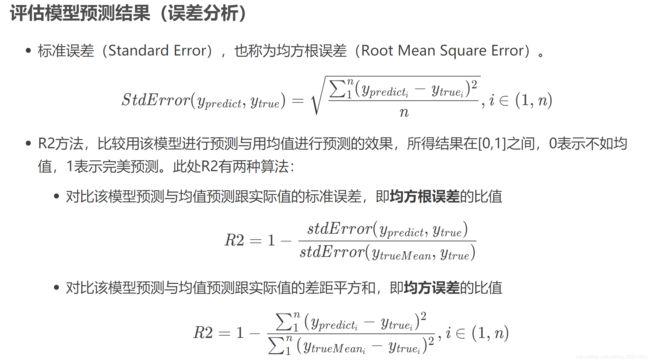python实现多元线性拟合、一元多项式拟合、多元多项式拟合
数据分析中经常会使用到数据拟合,本文中将阐述如何实现一元以及多元的线性拟合以及多项式拟合,本文中只涉及实现方式,不涉及理论知识。
模型拟合中涉及的误差评估方法如下所示:
import numpy as np
def stdError_func(y_test, y):
return np.sqrt(np.mean((y_test - y) ** 2))
def R2_1_func(y_test, y):
return 1 - ((y_test - y) ** 2).sum() / ((y.mean() - y) ** 2).sum()
def R2_2_func(y_test, y):
y_mean = np.array(y)
y_mean[:] = y.mean()
return 1 - stdError_func(y_test, y) / stdError_func(y_mean, y)
一元线性拟合
import pandas as pd
import numpy as np
from sklearn.preprocessing import PolynomialFeatures
from sklearn import linear_model
filename = "E:/data.csv"
df= pd.read_csv(filename)
x = np.array(df.iloc[:,0].values)
y = np.array(df.iloc[:,5].values)
cft = linear_model.LinearRegression()
cft.fit(x[:,np.newaxis], y) #模型将x变成二维的形式, 输入的x的维度为[None, 1]
print("model coefficients", cft.coef_)
print("model intercept", cft.intercept_)
predict_y = cft.predict(x[:,np.newaxis])
strError = stdError_func(predict_y, y)
R2_1 = R2_1_func(predict_y, y)
R2_2 = R2_2_func(predict_y, y)
score = cft.score(x[:,np.newaxis], y) ##sklearn中自带的模型评估,与R2_1逻辑相同
print(' strError={:.2f}, R2_1={:.2f}, R2_2={:.2f}, clf.score={:.2f}'.format(
strError,R2_1,R2_2,score))
结果输出为:
model coefficients [-31.2375]
model intercept 7.415750000000001
strError=1.11, R2_1=0.28, R2_2=0.15, clf.score=0.28
模型拟合的表达式为:
y = 7.415750000000001 +(-31.2375) * x
从拟合的均方误差和得分来看效果不佳
多元线性拟合
import pandas as pd
import numpy as np
from sklearn.preprocessing import PolynomialFeatures
from sklearn import linear_model
filename = "E:/data.csv"
df= pd.read_csv(filename)
x = np.array(df.iloc[:,0:4].values)
y = np.array(df.iloc[:,5].values)
cft = linear_model.LinearRegression()
print(x.shape)
cft.fit(x, y) #
print("model coefficients", cft.coef_)
print("model intercept", cft.intercept_)
predict_y = cft.predict(x)
strError = stdError_func(predict_y, y)
R2_1 = R2_1_func(predict_y, y)
R2_2 = R2_2_func(predict_y, y)
score = cft.score(x, y) ##sklearn中自带的模型评估,与R2_1逻辑相同
print('strError={:.2f}, R2_1={:.2f}, R2_2={:.2f}, clf.score={:.2f}'.format(
strError,R2_1,R2_2,score))
结果输出为:
model coefficients [-31.2375 17.74375 44.325 5.7375 ]
model intercept 0.5051249999999978
strError=0.58, R2_1=0.80, R2_2=0.56, clf.score=0.80
模型拟合的表达式为:
y = 0.5051249999999978 +(-31.2375) * x11 + 17.74375 *x2 + 44.325 * x3 + 5.7375 * x4
从拟合的均方误差和得分来看在之前的基础上有所提升
一元多项式拟合
以三次多项式为例
import pandas as pd
import numpy as np
from sklearn.preprocessing import PolynomialFeatures
from sklearn import linear_model
filename = "E:/data.csv"
df= pd.read_csv(filename)
x = np.array(df.iloc[:,0].values)
y = np.array(df.iloc[:,5].values)
poly_reg =PolynomialFeatures(degree=3) #三次多项式
X_ploy =poly_reg.fit_transform(x[:, np.newaxis])
print(X_ploy.shape)
lin_reg_2=linear_model.LinearRegression()
lin_reg_2.fit(X_ploy,y)
predict_y = lin_reg_2.predict(X_ploy)
strError = stdError_func(predict_y, y)
R2_1 = R2_1_func(predict_y, y)
R2_2 = R2_2_func(predict_y, y)
score = lin_reg_2.score(X_ploy, y) ##sklearn中自带的模型评估,与R2_1逻辑相同
print("model coefficients", lin_reg_2.coef_)
print("model intercept", lin_reg_2.intercept_)
print('degree={}: strError={:.2f}, R2_1={:.2f}, R2_2={:.2f}, clf.score={:.2f}'.format(
3, strError,R2_1,R2_2,score))
输出结果
model coefficients [ 0. 990.64583333 -11906.25 44635.41666667]
model intercept -20.724999999999117
degree=3: strError=1.08, R2_1=0.32, R2_2=0.17, clf.score=0.32
对应的函数表达式为 -20.724999999999117 + [0, 990.64583333, -11906.25, 44635.41666667] *[1, x, x^2, x.^3].T = -20.724999999999117 + 990.64583333 * x + ( -11906.25) * x^2 + 44635.41666667 * x^3
多元多项式拟合
import pandas as pd
import numpy as np
from sklearn.preprocessing import PolynomialFeatures
from sklearn import linear_model
filename = "E:/data.csv"
df= pd.read_csv(filename)
x = np.array(df.iloc[:,0:4].values)
y = np.array(df.iloc[:,5].values)
poly_reg =PolynomialFeatures(degree=2) #三次多项式
X_ploy =poly_reg.fit_transform(x)
lin_reg_2=linear_model.LinearRegression()
lin_reg_2.fit(X_ploy,y)
predict_y = lin_reg_2.predict(X_ploy)
strError = stdError_func(predict_y, y)
R2_1 = R2_1_func(predict_y, y)
R2_2 = R2_2_func(predict_y, y)
score = lin_reg_2.score(X_ploy, y) ##sklearn中自带的模型评估,与R2_1逻辑相同
print("coefficients", lin_reg_2.coef_)
print("intercept", lin_reg_2.intercept_)
print('degree={}: strError={:.2f}, R2_1={:.2f}, R2_2={:.2f}, clf.score={:.2f}'.format(
3, strError,R2_1,R2_2,score))
函数输出结果为:
coefficients [ 0. 332.28129937 -19.9240981 -9.10607925
-191.05593023 -287.93919929 -912.11402936 -1230.21922184
-207.90033986 99.03441748 190.26204994 433.25169929
273.13674555 257.66550523 344.92652936]
intercept 4.35175537840722
degree=3: strError=0.23, R2_1=0.97, R2_2=0.82, clf.score=0.97
代码中输入的自变量是一个包含四个变量的输入, 对应coefficients输出的是长度为15的向量, 其中对应到的变量分别为 variable_X = [1, x1, x2, x3, x4, x 1 ∗ x 1 x1*x1 x1∗x1, x 1 ∗ x 2 x1*x2 x1∗x2, x 1 ∗ x 3 x1*x3 x1∗x3, x 1 ∗ x 4 x1*x4 x1∗x4, x 2 ∗ x 2 x2*x2 x2∗x2, x 2 ∗ x 3 x2*x3 x2∗x3, x 2 ∗ x 4 x2*x4 x2∗x4, x 3 ∗ x 3 x3*x3 x3∗x3, x 3 ∗ x 4 x3*x4 x3∗x4, x 4 ∗ x 4 x4*x4 x4∗x4]
对应的方程式为: i n t e r c e p t + c o e f f i c i e n t s ∗ v a r i a b l e X . T intercept + coefficients * variable_X.T intercept+coefficients∗variableX.T
代码中涉及到的数据集如下:
a,b,c,d,e
0.06,0.2,0.02,0.1,0.340
0.1,0.28,0.02,0.14,0.370
0.12,0.32,0.02,0.16,0.377
0.08,0.24,0.02,0.12,0.383
0.08,0.32,0.04,0.1,0.383
0.12,0.28,0.03,0.1,0.393
0.1,0.24,0.05,0.1,0.385
0.06,0.32,0.05,0.14,0.362
0.12,0.2,0.05,0.12,0.320
0.06,0.28,0.04,0.12,0.393
0.08,0.28,0.05,0.16,0.402
0.08,0.2,0.03,0.14,0.349
0.1,0.2,0.04,0.16,0.335
0.1,0.32,0.03,0.12,0.387
0.12,0.24,0.04,0.14,0.390
0.06,0.24,0.03,0.16,0.315
指数函数和幂函数拟合参照网址:
https://blog.csdn.net/kl28978113/article/details/88818885
参考链接:
https://blog.csdn.
net/weixin_44794704/article/details/89246032
https://blog.csdn.net/bxg1065283526/article/details/80043049
https://www.cnblogs.com/Lin-Yi/p/8975638.html
